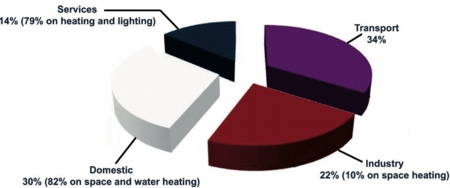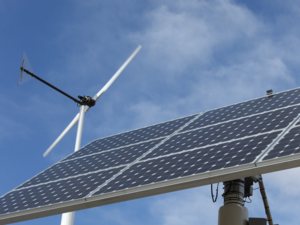Practical engineering to meet CRC obligations
You’ve registered for CRC but now need to draw up a carbon-management plan and target those areas of the business where the carbon savings are going to come from. Graham Child discusses the priorities.
In planning a strategy to reduce a building’s energy use and associated carbon emissions, the first thing to understand is how that building is currently performing. The industry recognised method is CIBSE guidance TM22. This is a benchmarking system for comparing building energy consumption with similar types of property. The calculations are adjusted for occupancy and weather to ensure that such variables are normalised. CIBSE TM46 provides a database of benchmarks for comparison.
It is essential that good records of metered energy consumption are kept over several years. Half-hourly electrical data is ideal for analysing load profiles. The load profiles will often reveal that energy is being consumed overnight or weekends when the building is unoccupied and major plant is expected to be off.
An analysis of the BMS will often reveal that plant is operating for extended time periods, presenting an opportunity to discuss in detail with building users how the building is used. For instance, in an office building, the core occupancy is possibly 8.30 a.m. to 5.30 p.m., yet because a minority work late or come in early, fresh-air plant is operated from 7 a.m. until 7 p.m. Such extended operation is unnecessary, and no detrimental effect will be found in large buildings if the fresh air plant is not operating if the occupancy is low for short periods.
It is not unusual to find that central-plant control strategies conceived five to 10 years ago can be changed to reduce energy consumption without seriously compromising environmental conditions.
Similarly, a faulty damper motor or linkage may be preventing recirculation of air, forcing the plant to heat or cool 100% outside air.
A full investigation of the BMS may also identify other options to reduce the energy demand.
Many buildings will benefit from a review of installed lighting systems, especially where fluorescent lighting utilises switch-start T8 lamps. These should be replaced with high-frequency ballasts and T5 lamps with an LOR (light output ratio) of at least 0.8 to deliver significant energy savings.
The development of LED lamps provides further opportunities to replace downlighters fitted with tungsten-halogen dichroic lamps. LED lamps also offer vastly superior lamp-life, reducing maintenance costs as well as energy consumption.
Control of lighting using PIRs and daylight sensing ensures that lighting is never on unless required.
Existing lighting-control systems can benefit from a review and upgrades to maximise energy savings. Typically the system would benefit from sub-dividing the controlled area into smaller sections, avoiding the illumination of large sections of an open-plan office if they are lightly occupied or only subject to a walk-through by a security guard.
Heating systems should be reviewed and their control strategy optimised to ensure that the operational hours suit the building’s usage. Many older heating systems would benefit from new controls capable of optimising the start time, providing weather compensation and the installation of thermostatic radiator valves.
Older boilers will not be as efficient as modern high-efficiency and condensing boilers. Other options worth considering are the introduction of a small ‘Summer’ boiler in preference to operating a large heating boiler just meet the HWS heating demand.
Cooling systems should be similarly examined to ensure they are operating at peak efficiency and for minimum operating periods.
Older cooling systems may employ R22 as a refrigerant. This is no longer available from virgin stocks, so they will become increasingly expensive to maintain. A fully costed appraisal may demonstrate that replacement high-efficiency cooling plant will deliver significant energy savings whilst alleviating the need to continue maintaining old R22 equipment.

Mechanically ventilated buildings with central plant require a review of fresh-air volumes and may provide an opportunity to reduce the volumes to closely match the occupancy. This may be a variable volume of fresh air or a permanent reduction. Reducing air volume will not only reduce fan power but also reduce the heating and cooling loads.
Lifts are another target to save energy. Operating lifts in standby mode during off-peak and idle periods by switching of power to the controller, auxiliary equipment, lighting and ventilation or implementing a lift control strategy that minimises the number of lift movements and fitting lift cars with LED lighting will all reduce energy consumption.
Other options are fitting variable-speed motors to reduce speeds where traffic is light and fitting a regenerating lift drive system to export energy generated for use elsewhere on the site.
There is no doubt that maintaining plant properly will maximise efficiency and reduce energy. Simple things like keeping filters clean will reduce fan power. Making sure DX cooling units are correctly charged avoids loss of efficiency. Water treatment to reduce corrosion and sludge build-up in heat emitters helps heating systems operate efficiently.
Once the building services as designed are working at peak efficiency, investment in energy-saving technologies can be considered.
These could include voltage optimisation, where savings of around 10 to 12% are possible.
Hospitals, leisure centres and hotels lend themselves to installing combined heat and power (CHP) matched to the continuous heating load and providing opportunities to export electricity to the grid when not required on site.
Further investment in low/zero carbon technologies can be funded from Feed-In Tariffs (FIT) and, from next April, the Renewable Heat Incentive (RHI, about which a Government announcement expected very soon).
FITs are already creating of lot of interest in Solar PV installations, which benefit from the basic FIT for generated electricity but also for the tariff available for export to the grid.
The arrival of RHI should accelerate the uptake of biomass, heat pumps and solar thermal.
These technologies are not always easy to add to existing buildings and will represent a significant investment — so the first way to reduce carbon emissions is to optimise the operation of existing building-services systems.
Graham Child is a director of Banyard Consulting Ltd









